On June 12, 2025, tragedy struck shortly after takeoff from Ahmedabad airport when Air India flight AI171, a Boeing 787-8 Dreamliner bound for London Gatwick, crashed into a residential area. The catastrophe claimed the lives of 241 of the 242 people on board, along with an unknown number of residents on the ground, bringing the death toll to at least 265. The disaster has left families shattered, investigators scrambling for answers, and the aviation community in mourning.
The sole survivor, 40-year-old British businessman Vishwash Kumar Ramesh, recounted the horror from his hospital bed. Sitting in seat 11A next to an emergency exit, Ramesh described the plane feeling “stuck in the air” moments after takeoff, with cabin lights flickering green and white before the aircraft slammed into a building and exploded. “I managed to unbuckle myself, used my leg to push through that opening, and crawled out,” he said. Despite suffering burn injuries to his left arm and bruises, he escaped the wreckage that claimed the lives of air hostesses and fellow passengers right before his eyes.
Prime Minister Narendra Modi visited Ramesh in hospital on June 13, expressing condolences and solidarity. Modi also toured the devastated neighborhood, where debris from the plane was embedded in the BJ Medical College building. At least five medical students were killed and around 50 injured on the ground.
Families of victims have been enduring agonizing waits to identify and reclaim the bodies of loved ones. With most bodies badly charred, doctors have been working tirelessly to collect DNA and dental samples for identification. Forensic dentist Jaishankar Pillai revealed that dental records for 135 victims had been gathered to aid this painstaking process. Rafiq Abdul Hafiz Memon, who lost four relatives, lamented the lack of information, saying, “We have lost our children… we are not understanding anything. Please help us get information about our children.” Another father, awaiting the body of his son Harshad Patel, was told DNA profiling would take 72 hours. The slow pace has heightened tensions among grieving families.
The crash site remains a somber scene, with rescue teams and sniffer dogs continuing to comb through the wreckage. Officials have recovered 270 bodies, including those of passengers and people on the ground. A committee formed by India’s Ministry of Civil Aviation is investigating the root cause of the crash and will report within three months, having access to flight data, cockpit voice recordings, and maintenance records.
British investigators from the Air Accidents Investigation Branch (AAIB) arrived in Ahmedabad to assist Indian and American teams. Natarajan Chandrasekaran, head of Air India’s parent company Tata, called the event “one of the darkest days in the Tata Group’s history” and pledged full cooperation and transparency. The black box recorder, recovered 28 hours after the crash, is expected to shed light on the catastrophe.
Preliminary CCTV footage shows the plane began to lose control just 17 seconds after takeoff, reaching only 650 feet before plummeting. Audio from the cockpit reveals the captain, Sumeet Sabharwal, with 8,200 hours of flying experience, reported “no thrust” and was “unable to lift” the aircraft. The plane’s landing gear was still down after takeoff—a highly unusual circumstance that investigators are scrutinizing. Experts speculate this could indicate mechanical failure or a distraction amid a critical emergency.
Adding to the mystery, videos suggest the plane’s wing flaps were retracted, reducing lift and increasing drag. Aviation consultant Jeff Guzzetti noted these details could answer some basic factual questions once analyzed. Bird strike, a common cause in similar incidents, has been ruled out.
The crash was the first fatal accident involving a Boeing 787-8 Dreamliner since its 2011 debut. The Indian aviation regulator has ordered Air India to conduct safety checks on its entire Boeing 787 fleet, focusing on fuel parameters, engine control systems, and takeoff procedures. This comes amid reports that a similar 787 jet made four emergency landings in early 2025 due to wing flap issues.
Among the victims were entire families from London, including the Shantilal Lalgi family, the Baxi sisters Dhir and Heer, and the Saiyedmiya family. The Baxi sisters, in their early 20s, had flown to India to surprise their grandmother for her birthday. Their cousin described them as having an “amazing aura” and dreams of “roaming around the world.” Another grieving family lost both parents in the crash after their only son, a pilot, died in a previous aviation accident in France.
In East London, Master Mohammed Adnan, his wife, and 11-month-old baby were among the deceased. The mosque he worshipped at extended condolences to the family. NHS nurse Renjitha Gopakumaran, who worked at Queen Alexandra Hospital in Portsmouth and was returning from a holiday in India, was also named among the victims. Colleagues remembered her as a “beautiful lady” who showed “so much love and care.”
Other British victims include recruitment consultant Akeel Nanabawa, his wife Hannaa, and their daughter Sara from Gloucester; mum-of-three Raxa Modha and her grandson Rudra from Wellingborough; and wellness entrepreneurs Fiongal and Jamie Greenlaw-Meek. A couple who lost their only son in a prior crash were also on board, returning from a religious celebration.
The tragedy has prompted mourning across the UK. Vigils were held in London’s Southall and Harrow, and flags at Parliament flew at half-mast. King Charles wore a black armband during the Trooping the Colour ceremony on June 14 in tribute to the victims and their families.
The Foreign, Commonwealth and Development Office has been actively supporting British nationals affected by the disaster. British High Commissioner Lindy Cameron met with Prime Minister Modi, and a consular team was dispatched to India. The Foreign Office helpline received nearly 300 calls by June 13. Family members of survivor Vishwash Kumar Ramesh were flying to India to be with him and search for his brother Ajay, who is feared dead.
The crash has also reverberated internationally. Seven Portuguese victims—all UK residents—were identified, as was a Canadian dentist, Nirali Sureshkumar Patel, mother of a one-year-old child. Patel’s death has deeply saddened her community in Mississauga, Ontario.
Air India CEO Campbell Wilson visited the crash site, expressing “deep sorrow” and pledging full assistance. Boeing’s CEO Kelly Ortberg canceled his planned trip to the Paris Airshow to focus on the investigation, emphasizing safety as foundational to the industry.
Meanwhile, tensions in the Middle East have disrupted Air India’s operations. On June 14, at least 16 flights were diverted due to the closure of Iranian airspace amid escalating Israel-Iran hostilities. A Mumbai to London flight turned back mid-journey, highlighting the wider regional impact of geopolitical strife.
The investigation into the Air India crash continues amid a backdrop of grief and resilience. As families await answers, the aviation community is left grappling with the challenges of ensuring safety in an increasingly complex world. The story of flight AI171 is a solemn reminder of the fragility of life and the profound human cost of tragedy.


